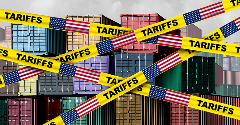News
FDA reviews red food colour additive, Red No.3
9 Jan 2025Amid considerations to tighten regulations around artificial ingredients, the US Food and Drug Administration (FDA) is exploring a potential ban on particular type of red food dye.
Following a formal request, the US Food and Drug Administration (FDA) is actively reviewing the petition for Red No. 3, approved under the Federal Food, Drug, and Cosmetic Act (FD&C Act). Red No. 3 is a red food colour additive made from petroleum that produces a bright cherry-red colour.

Food additive legislation differs across the world
Legislation on the permitted use of additives in food and drinks differs depending on the country. Authorities undertake safety and quality assessments to determine the use of specific additives entering the food supply, including colour. However, due to varying assessment approaches, cultural attitudes, and regulatory priorities, authorities often come to different conclusions.
Food colouring broadly falls into two categories: artificial and natural.
Natural colouring refers to pigments from naturally derived sources, such as plants, animals and minerals. Whereas artificial colouring – manufactured colours added to foodstuff during production – falls under food additives as they alter the natural state of the product’s colouration.
Food additive laws
In the US, the FD&C Act sets out a framework for governing food additives and those approved by the FDA.
In the European Union (EU), several regulations govern the requirements, specifications, and authorisation procedures surrounding the use of food additives.
In Japan, Act No. 233 of 24 December 1947, the Japan Food Sanitation Act/Japan Food Sanitation Law (JFSL), governs food safety and quality, with the Ministry of Health and Welfare Notification No. 370 (1959) setting out specifications and standards for foods and food additives.
Singapore has regulatory requirements for food additives, with the Singapore Food Agency performing food safety assessments before additives can be sold in the Asian market.
Food additive re-evaluations and reviews
Regardless of whether an ingredient, like food additives, has been approved, agencies like the FDA can and do review ingredients post-approval and market entry to ascertain their ongoing presence in the food supply chain.
In the EU, the European Food Safety Authority (EFSA) is currently re-evaluating all food additives authorised for use in the EU before 20 January 2009. Specified under Regulation (EU) No 257/2010, as of 4 November 2024, EFSA had reviewed more than 70% of the 315 food additives applicable.
The Food Safety and Standards Authority of India has continued to propose amendments to the draft Food Safety and Standards (Food Products Standards and Food Additives) Amendment Regulations, 2021.
Now, in the US, the FDA is examining the specific issue of artificial food colouration, pertaining to one specific red food dye, FD&C Red No. 3.
FDA is re-analysing Red No.3 food colouring
“The FDA is actively reviewing a petition filed for FD&C Red No. 3, which proposed that the FDA repeal the colour additive regulations for the use of FD&C Red No. 3 in foods and ingested drugs,” a spokesperson for the FDA told Ingredients Network.
Whether Red No.3 food colouring is permitted for future use in foods closely revolves around the Delaney Clause, which entered into the US FD&C Act as part of the Food Additives Amendment 1958. The Delaney Clause requires the FDA to ban food additives that, through testing, have been found to cause or induce cancer in humans or animals.
However, under the FDA’s FD&C Act, colour additives are not included in the definition of food additives. The FDA states that “other legal pre-market approval requirements apply”. Under the Act, through (Chapter VII, section 721), colour additives including FD&C Red No. 3 are subject to FDA approval before they can be used in food that comes into contact with the bodies of people or animals for a significant period. Currently, the CFR – Code of Federal Regulations Title 21 (fda.gov) is the relevant colour additive regulation for FD&C Red No 3.
Yet, in the US different legislative rules exist for using Red No. 3 in cosmetics and topical drugs compared to food, prompting calls for its ban in food production.
Under the Delaney Clause, the FDA denied a petition to authorise the use of the colour additive in cosmetics and topical drug applications due to the presence of data showing its connection with animal carcinogenicity. In 1990, when this decision was made, the use of this dye, Red No. 3, was authorised for use in foods and ingested drugs.
“The way that Red No. 3 causes cancer in animals, specifically rats, does not occur in humans, so these animal results have limited relevance to humans,” the FDA said. “Because these studies did not raise safety concerns, the FDA did not take action to revoke the authorisation of Red No. 3 in food,” the spokesperson added.
Under FDA rules, most colour additives, including Red No. 3, require the Administration to undertake a pre-market review and approval of the food colourant. With Red No.3 in particular, the FDA only permits the colour additive from certified batches. FDA chemists must, therefore, have analysed a batch sample of Red No. 3 dye and confirmed it meets the composition and purity requirements set out by law.
“The FDA hopes to make a regulatory determination on FD&C Red No. 3 soon,” the FDA spokesperson added. The Administration has also stated that FDA scientists will continue to review publicly available information about the safety and toxicology of colour additives to ascertain whether their use continues to be safe under the FD&C Act.
Related news

NMN: An on-trend ‘fountain of youth’ ingredient for anti-ageing products
24 Oct 2025
Dubbed an “on-trend fountain of youth ingredient” by Mintel, NMN is booming in anti-ageing ingestible products in Asia – but regulatory roadblocks are thwarting NPD efforts elsewhere, say experts.
Read more
Food security-insecurity gap grows, hitting vulnerable regions hardest
16 Oct 2025
While food security has increased in most countries, the world’s most vulnerable nations’ struggles continue and intensify, a USDA analysis reveals.
Read more
India’s biscuit and cookie consumers want extra indulgence
16 Sep 2025
Premiumisation, health consciousness, and a focus on texture are driving new product developments (NPD) in the Indian biscuit and cookie market, Mintel figures suggest.
Read more
Climate change threatens matcha supplies as social media fuels matcha mania
8 Sep 2025
Matcha’s popularity is rising across the globe, yet shrinking harvests caused by record-breaking heatwaves in Japan are dwindling global supplies.
Read more
Australia's snacking sector achieves near-universal appeal
22 Aug 2025
As many as 99% of Australian consumers snack daily, with generational differences and increasing demands presenting novel manufacturing opportunities, according to Mintel data.
Read more
World Food Safety Day shines a spotlight on science
19 Jun 2025
On 7 June, the World Health Organization (WHO) held its annual World Food Safety Day, highlighting the role scientific research and innovation play in supporting consumers’ health.
Read more
Africa and Middle East most vulnerable markets to food fraud
28 May 2025
Consumers in Africa and the Middle East face a higher risk of consuming adulterated foods – especially with tariffs causing chaos in the global food supply chain, experts warn.
Read more
East takes on West in the fight for future food flavours
30 Apr 2025
Asian and South American flavours are now key components on global menus, driven by a growing global appetite for culinary mashups.
Read more
Will Trump lower tariff hikes?
25 Apr 2025
The US President’s plan to reduce the 145% tariffs on China’s food and beverage market raises questions over whether a turnaround is likely for other regions.
Read more
Future F&B flavours favour exploration and explosive taste profiles
25 Mar 2025
Exploration and experimentation will define the future of flavour, according to Mintel, as consumers seek out taste profiles and textures that offer an adventurous eating experience.
Read more